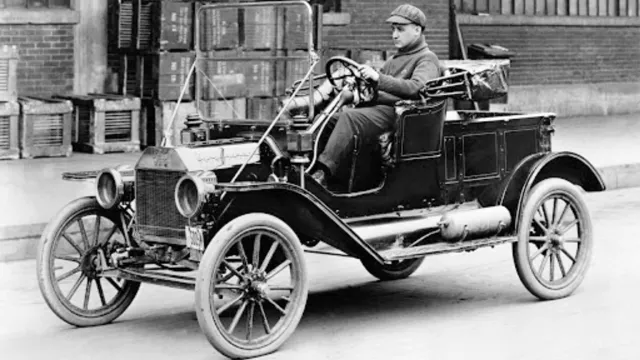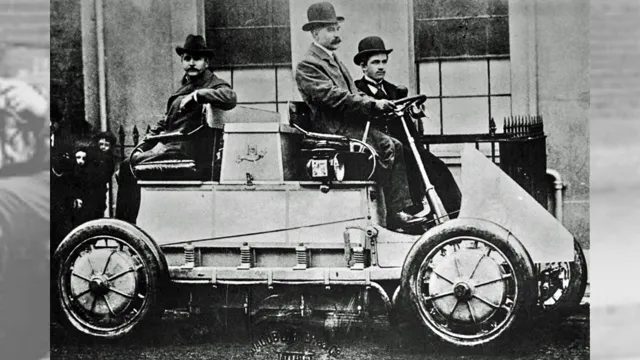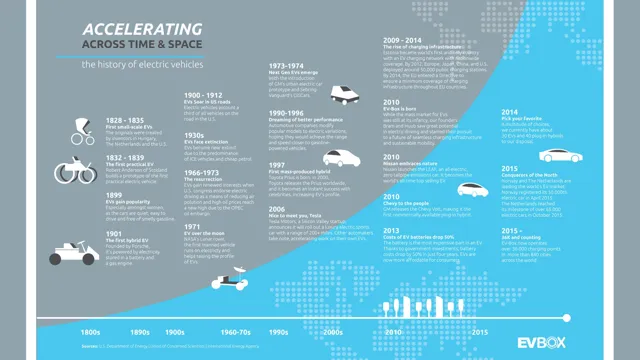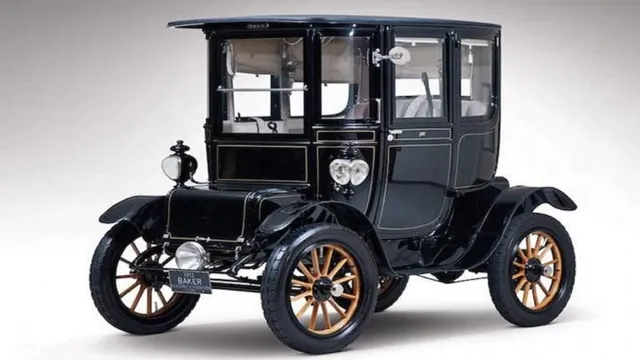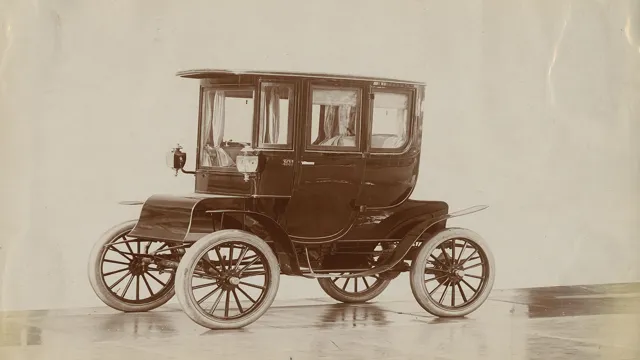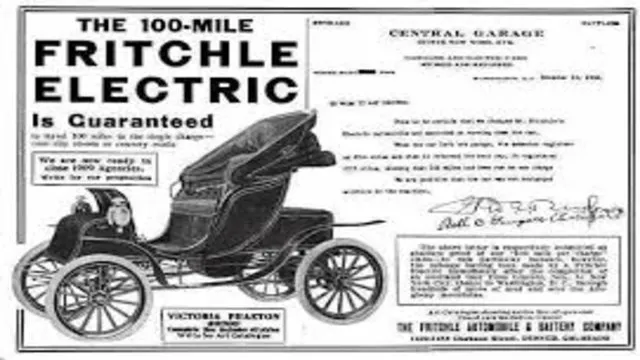Revolutionizing Transportation: Exploring the Fascinating History of Electric Cars in a Downloadable PDF
Electric cars are rapidly gaining popularity as people look for ways to reduce their carbon footprint and cut down on fuel costs. But, did you know that the history of electric cars dates back to the 1830s? That’s right, electric cars are not a new invention, but rather a technology that has been around for almost two centuries. In this comprehensive PDF guide, we will take a closer look at the fascinating history of electric cars.
From the early experiments in the 1830s to the modern-day EV industry, we will explore how electric cars have evolved over time. You will discover the important role that electric cars played in the early days of automobile manufacturing, and how they were eventually overshadowed by gasoline-powered engines. We will also delve into the factors that led to the resurgence of electric cars in recent years.
With advancements in battery technology and the increasing concern over climate change, electric cars are quickly becoming a viable alternative to traditional cars. Moreover, we will discuss the future of electric cars and how they are poised to revolutionize the transportation industry. We will look at the major players in the electric car market, such as Tesla and Nissan, and examine their impact on the industry.
Overall, this comprehensive PDF guide will provide you with a deep understanding of the history of electric cars. You will learn about the challenges that early inventors faced, the technological advancements that propelled the industry forward, and the current state of the EV market. Whether you are a history buff or a green energy enthusiast, this guide has something for everyone.
What is an Electric Car?
Electric cars are automobiles that are powered by an electric motor instead of a traditional internal combustion engine. These vehicles use electricity stored in batteries to power the motor and propel the car forward. The concept of electric cars dates back to the early 1800s, but the technology did not become practical until the late 1800s with the development of reliable rechargeable batteries.
However, the popularity of electric cars diminished in the early 1900s with the rise of gasoline-powered vehicles due to the cheaper price and ability to travel longer distances. Today, electric cars are making a comeback as technology has advanced, making production more affordable and allowing for greater driving ranges. In fact, electric cars are becoming increasingly popular as more people seek to reduce their carbon footprint and dependence on fossil fuels.
If you are interested in learning more about the history of electric cars, you can find an electric car history pdf easily with a quick online search.
Defining Electric Cars
So, what exactly is an electric car? Well, simply put, it’s a vehicle that runs entirely on electricity. Unlike conventional cars that rely on internal combustion engines, electric cars use electric motors powered by rechargeable batteries. This means that instead of filling up at a gas station, electric car owners have to recharge at dedicated charging stations or using specially designed charging equipment at home.
It’s a clean and green alternative to traditional cars, emitting zero emissions and helping to reduce environmental pollution. Electric cars are becoming increasingly popular as people strive to live more sustainable lifestyles and reduce their carbon footprint. Although there are some limitations to electric cars, such as range anxiety and high initial costs, the benefits they offer are certainly worth considering.
So, if you’re interested in reducing your impact on the environment, an electric car might just be the perfect choice for you!
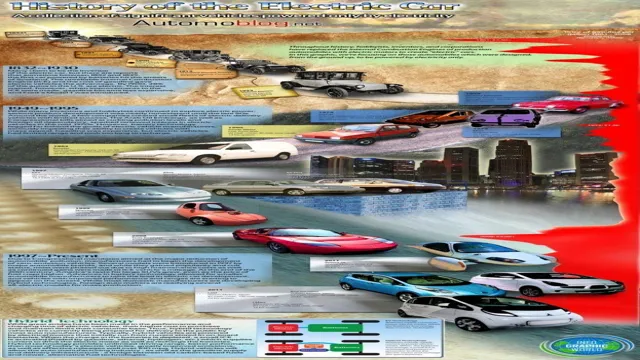
Early Electric Car Motors
Electric Car Electric cars have been around for more than a century, and their technology has come a long way since then. Early electric car motors were simpler than today’s versions, with fewer moving parts. These motors used direct current (DC), which was easy to produce with the available equipment of the time.
They also required less maintenance, as they had fewer parts that could wear out. However, early electric cars had a limited range, as the batteries needed to power them were not as efficient as they are today. Despite this, electric cars were popular with early drivers, as they were quiet and easy to operate, and they emitted no pollutants.
Today, electric cars have become more sophisticated, with advanced batteries and motors that can travel further and faster than ever before. However, the early electric car motors paved the way for the modern vehicles we see on the roads today.
The Rise and Fall of Electric Cars
Electric cars may seem like a modern invention, but their history dates back to the 1800s. The early versions of electric cars relied on primitive batteries that couldn’t hold much of a charge and didn’t have proper electric motors, making them relatively inefficient. However, interest in electric cars picked up in the late 19th century as people began to see the potential for cleaner, quieter transportation.
The first electric car was invented in 1891 by William Morrison of Des Moines, Iowa. Electric cars remained popular through the early 20th century, particularly in urban areas where their compact size and lack of pollution were big selling points. However, the advent of mass-produced gasoline-powered cars and the discovery of cheap oil reserves led to a decline in electric car production.
In more recent years, concerns about climate change and fossil fuel depletion have led to a resurgence of interest in electric cars. As battery technology improves and charging infrastructure becomes more widespread, it’s likely we’ll see more and more electric cars on the road in the coming years. If you’re interested in learning more about the history of electric cars, there are plenty of resources available online, including an electric car history PDF that covers the topic in depth.
Early Adoption and Advancements
Electric Cars Early adoption and advancements in electric cars have led to a rise and fall in their popularity over the years. The first electric car was developed in the 1830s, but it wasn’t until the 1990s that they began to gain popularity. Advances in battery technology and environmental concerns saw a surge in interest, and major car manufacturers began producing electric cars.
However, they were expensive and had limited range, so their adoption was slow. In the early 2000s, the popularity of electric cars waned as gas prices dropped and hybrid cars became more popular. It wasn’t until Tesla Motors introduced the Model S in 2012 that electric cars began to regain popularity.
Advances in battery technology and increased production have made electric cars more affordable and with longer ranges, making them a viable alternative to gas-powered cars. As more and more people become environmentally conscious, the demand for electric cars is on the rise once again.
Competition from Internal Combustion Engines
The competition from internal combustion engines was one of the many factors that led to the rise and fall of electric cars. In the early 1900s, electric cars were quite popular, and they were even seen as a threat to gas-powered cars. However, with the discovery of vast reserves of oil and the development of more efficient gasoline engines, electric cars soon fell out of favor.
In the 1970s, there was a resurgence of interest in electric vehicles due to concerns about oil shortages and pollution. However, the technology was not yet advanced enough, and the cars were expensive and not very practical. In recent years, with advances in battery technology and a renewed focus on environmental concerns, electric cars are once again on the rise.
However, they still face competition from gas-powered cars, and it remains to be seen whether they will ultimately be the preferred choice of consumers.
Electric Car Decline
The rise and fall of electric cars has been a tumultuous journey. Once seen as the future of the automobile industry, electric cars have recently experienced a decline in popularity. While a few years ago people were excited about the potential of electric cars to combat climate change and reduce dependence on fossil fuels, more and more people are now turning back to traditional gasoline-powered cars.
The reasons for this shift are multifaceted, but cost is a significant factor. Electric cars have yet to become cost-competitive with gasoline-powered cars, and the initial investment required to purchase an electric car often remains prohibitively expensive for many consumers. Additionally, the limited range of electric cars and the scarcity of charging stations can make them less convenient to own.
While the popularity of electric cars may have decreased, it is important to note that the future of sustainable transportation is still hopeful. As technology improves, electric cars will continue to become more efficient and cost-effective. In short, while the decline of electric cars is disappointing, it is not the end of the road for sustainable transportation options.
Revival of Electric Cars in the Modern Era
Electric cars have been around for more than a century, but they truly began to revive in the modern era. In the 1800s, electric cars were a common sight on streets until gasoline cars took over due to their longer range. However, with the concern of climate change looming, automakers began to invest in electric vehicles.
Tesla’s Model S became the first electric car to have a range of over 300 miles, making electric vehicles more feasible for long trips. In addition, the development of more efficient and cheaper lithium-ion batteries allowed for electric cars to become more accessible to the general public. As a result, electric cars continue to gain popularity with more people seeing the benefits of owning one, such as reduced emissions and lower operating costs.
You can find more information on the history of electric cars in a free electric car history pdf available online.
Environmental and Economic Incentives
Environmental and Economic Incentives The revival of electric cars in the modern era has been driven by both environmental and economic incentives. Governments around the world are offering tax credits and other incentives to encourage the adoption of electric vehicles to reduce carbon emissions. As the technology has improved and costs have decreased, electric cars have become more attractive to consumers as well.
In addition to being better for the environment, electric cars offer lower operating costs and reduced maintenance requirements. They also offer a quieter and smoother driving experience, and the convenience of charging at home. With major car manufacturers investing in the development of electric vehicles, and with more charging stations being installed around the world, the future looks bright for the electric car industry.
So, why not consider making the switch to an electric car and be a part of the solution to reducing carbon emissions while also saving money on fuel costs?
Improvements in Battery Technology
One of the most significant improvements in technology over the last few decades has been the development of better batteries for electric vehicles. This innovation has been a driving force behind the revival of electric cars in the modern era. In the past, electric vehicles were often limited by their range and the time it took to recharge.
However, new battery technologies have significantly improved these issues, leading to more efficient and practical electric cars. Today’s batteries can provide a longer range for electric cars, and recharging times have been reduced drastically. The efficiency of electric cars has improved thanks to the use of lithium-ion batteries, which provide more power and capacity than their predecessors.
Additionally, advancements in battery management systems have made it easier to monitor and control battery usage, resulting in longer battery life and lower risks of battery failure. Overall, the improvements in battery technology have made electric cars a more viable option for people looking to reduce their carbon footprint and contribute to a cleaner environment while still enjoying the convenience of personal transportation.
Types of Electric Cars
When we talk about electric cars, there are actually four types that you should know about. These are battery electric vehicles (BEVs), plug-in hybrid electric vehicles (PHEVs), hybrid electric vehicles (HEVs), and fuel cell electric vehicles (FCEVs). Electric car history PDFs will say that BEVs and PHEVs are the most commonly used types of electric cars in the market today, with BEVs being the pure electric vehicles that run solely on electricity stored in its battery whereas PHEVs require both electricity and gas to run.
On the other hand, HEVs use both internal combustion engine and electric motor but do not have a plug-in feature. Lastly, FCEVs use fuel cells to convert hydrogen into electricity, making it one of the cleanest and most efficient types of electric cars. Understanding the different types of electric cars is important for choosing which one fits your needs and lifestyle, whether you’re looking for a pure electric experience or a hybrid option.
Battery Electric Vehicles (BEV)
Battery Electric Vehicles (BEV) As we become more aware of the importance of transitioning to renewable energy sources, electric cars have become increasingly popular. Electric vehicles come in different forms, but one of the most common types is the Battery Electric Vehicle (BEV). BEVs are powered entirely by batteries that are charged by an external source, such as a charging station or a wall outlet.
They do not have a gasoline engine, which means they emit no pollutants or greenhouse gases while operating. BEVs have no tailpipe emissions, making them an eco-friendly option for those looking to reduce their carbon footprint. They are also a good financial investment because they are cheaper to maintain and operate compared to gas-powered cars.
Although BEVs typically have a shorter range compared to hybrid or gas vehicles, advances in battery technology have made range anxiety less of a concern. An investment in a BEV is not just a purchase of a vehicle; it’s an investment in a better, greener future.
Hybrid Electric Vehicles (HEV)
Hybrid Electric Vehicles (HEV) When it comes to electric cars, there are several types to choose from. One popular option is the hybrid electric vehicle, or HEV. These cars are designed to run on both electricity and gasoline, which can help reduce emissions and save money on fuel costs.
There are two types of HEVs: series and parallel. In a series hybrid, the gasoline engine is used only to generate electricity for the electric motor. The electric motor then powers the car’s wheels.
In a parallel hybrid, both the gasoline engine and the electric motor are used to power the car’s wheels. The car switches between the two sources of power depending on driving conditions. HEVs also use regenerative braking to charge the car’s battery.
This means that when you brake, the energy from the car’s motion is transferred back to the battery. This system can help extend the car’s electric range. Overall, HEVs are a great option for those who want to reduce their carbon footprint, but still enjoy the convenience and range of a gasoline-powered car.
Plug-In Hybrid Electric Vehicles (PHEV)
When it comes to electric cars, there are three main types: Battery Electric Vehicles (BEVs), Hybrid Electric Vehicles (HEVs), and Plug-In Hybrid Electric Vehicles (PHEVs). PHEVs are a great option for those who want the best of both worlds – the electric power of a BEV and the long-range potential of an HEV. PHEVs have both a gas engine and an electric motor, which means they can run purely on electric power for a certain distance before the gas-powered engine kicks in.
The main advantage of PHEVs is that they have a longer driving range compared to BEVs, making them more practical for long trips or commuting. Additionally, PHEVs can be charged at home or work, just like a BEV. Overall, PHEVs are a versatile and environmentally-friendly option for those looking to reduce their carbon footprint while maintaining their freedom to travel long distances.
Future of Electric Cars
Electric cars have come a long way since their inception, and the history of electric cars is quite fascinating. Way back in the early 1800s, electric cars were already starting to become a popular mode of transportation. One could argue that the first electric car was built way back in 1828 by a Hungarian inventor named Ányos Jedlik.
Throughout the years, many inventors improved upon the electric car, but it wasn’t until the 1990s that electric cars really started to take off. Fast forward to the present day, and electric cars are more popular than ever before, with many major car companies offering their own electric car models. As more and more people become concerned about the environment, the future of electric cars looks very bright indeed.
If you want to learn more about the history of electric cars, a quick search for an electric car history PDF will provide you with a wealth of information.
Growth and Predictions for the Industry
The future looks bright for electric cars. With advancements in battery technology and increased public awareness of the benefits of electric vehicles, the industry is poised for growth in the coming years. Industry experts predict that by 2030, 40% of new cars sold will be electric.
What’s driving this growth? For one, electric cars are becoming more affordable and accessible as production increases. Additionally, governments around the world are incentivizing electric vehicle adoption with tax credits and subsidies. As a result, consumers are increasingly seeing the economic benefits of electric cars in terms of lower fuel and maintenance costs.
Furthermore, the push for sustainable transportation is only getting stronger, creating a demand for carbon-neutral alternatives to gasoline-powered vehicles. As the infrastructure for electric car charging stations expands, more consumers will feel comfortable owning an electric car, adding to the industry’s growth. Overall, the future of electric cars looks promising, and there’s no doubt they will play a significant role in shaping the future of transportation.
Advancements in Sustainability and Performance
The future of electric cars looks promising with advancements in battery technology and infrastructure for charging stations. With a shift towards sustainable modes of transportation, automakers are investing heavily in electric vehicles (EVs) to meet the growing demand for eco-friendly travel options. EVs not only have zero emissions but also offer superior performance compared to traditional gasoline-powered cars, with faster acceleration and smoother driving experiences.
The batteries used in EVs are becoming more efficient and can now travel longer distances before needing a recharge. As infrastructure improves, drivers will have more access to charging stations, making EVs a more accessible option for daily use. With new models hitting the market each year, the future of electric cars is bright, and the environment and drivers alike will benefit from this shift towards cleaner, high-performing vehicles.
Technology and Infrastructure Challenges
The future of electric cars is bright, but there are challenges when it comes to technology and infrastructure. One of the biggest hurdles is the limited range of these vehicles. While improvements have been made in battery technology, allowing some electric cars to travel upwards of 300 miles on a single charge, there is still a long way to go before these vehicles can match the range of traditional gas-powered models.
Additionally, the infrastructure for electric cars is not yet as widespread as it needs to be. While there are more charging stations being installed every day, there are still many areas where electric car owners may struggle to find a convenient place to charge their vehicles. However, despite these challenges, the future of electric cars looks promising.
Many countries are committing to phasing out gas-powered vehicles in the coming years, and major automakers are investing heavily in electric car development. With continued improvements in battery technology, it may not be long before electric cars can match or even surpass the range of traditional vehicles. And as more charging stations are installed and electric cars become more commonplace, the infrastructure challenges will become less of an issue.
In the end, the transition to electric cars will require a concerted effort from governments, automakers, and consumers. But as we work towards a cleaner, more sustainable future, it’s clear that electric cars have a big role to play. And as the technology and infrastructure continue to improve, these vehicles will only become more appealing to drivers looking to make a positive impact on the environment.
Conclusion
As the pages of electric car history turn, it is clear that the path to the widespread adoption of electric vehicles has been a winding and often bumpy road. From their early beginnings as curiosities to their current position as a legitimate alternative to traditional gasoline-powered cars, electric vehicles have faced numerous challenges and overcome countless hurdles. However, with advances in technology and a growing awareness of the benefits of sustainable transportation, the future looks bright for the electric car industry.
So let’s embrace this electrifying revolution, and drive into a cleaner, greener tomorrow!”
FAQs
What is the history of electric cars?
Electric cars have a long history dating back to the 1830s, but it was not until the late 1990s that they began to gain popularity.
What are the benefits of electric cars?
Electric cars have several benefits, including lower emissions, reduced fuel costs, and quieter operation.
What is the range of electric cars?
The range of electric cars varies depending on the model, but can be anywhere from 80 to over 300 miles on a single charge.
How does charging an electric car work?
Electric cars can be charged at home or at public charging stations using either a Level 1 or Level 2 charger, with faster charging available at Level 3 DC fast charging stations.
Are there any government incentives for purchasing an electric car?
In some countries, there are government incentives for purchasing electric cars, such as tax credits or rebates. It’s worth researching what incentives may be available where you live.
